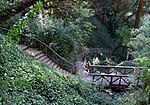Kensington, California
1911 establishments in CaliforniaBerkeley HillsCensus-designated places in CaliforniaCensus-designated places in Contra Costa County, CaliforniaPopulated places established in 1911 ... and 2 more
Unincorporated communities in CaliforniaUnincorporated communities in Contra Costa County, California

Kensington is an unincorporated community and census designated place located in the Berkeley Hills, in the East Bay, part of the San Francisco Bay Area, in Contra Costa County, California. In the 20th century it was considered part of Berkeley, although it is across the county line. House numbers follow the pattern used in Berkeley, and Kensington shares two zip codes with the Berkeley Hills area. The population was 5,077 at the 2010 census.
Excerpt from the Wikipedia article Kensington, California (License: CC BY-SA 3.0, Authors, Images).Kensington, California
Arlington Avenue,
Geographical coordinates (GPS) Address Nearby Places Show on map
Geographical coordinates (GPS)
| Latitude | Longitude |
|---|---|
| N 37.910555555556 ° | E -122.28027777778 ° |
Address
Arlington Avenue & Westminster Avenue
Arlington Avenue
94707
California, United States
Open on Google Maps





